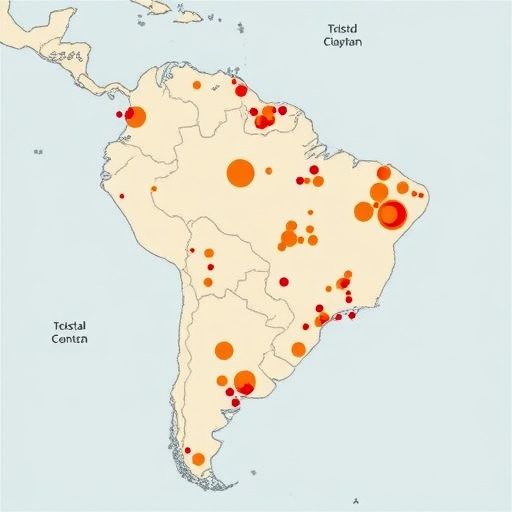In the world of botany and ecology, the intricate dance between fire and plant life is a topic of great importance and complexity. The tree fern, specifically Cyathea mexiae, serves as a compelling case study in understanding the post-fire phenology—essentially the timing of life cycle events—of flora in response to fire disturbances. This research delves into the mechanisms and adaptations that these ferns employ following fire incidents at the fringes of semideciduous forests in Brazil, adding crucial knowledge to our understanding of forest dynamics and resilience.
The edge of a semideciduous forest represents a unique intersection where two ecological worlds converge. Here, the tree fern Cyathea mexiae thrives, showcasing remarkable adaptation strategies that allow it to rebound and flourish after the incinerating force of fire. These adaptations are vital for the survival of the species and play a pivotal role in the broader ecological community. Understanding the phenological responses of species like Cyathea mexiae is essential as these insights can inform conservation strategies in regions affected by wildfires.
When considering the environmental pressures faced by semideciduous forests, fire stands out due to its dual nature as a destructive force and a regenerative catalyst. Post-fire regeneration is a complex process, intricately tied to species-specific responses, soil conditions, and the surrounding ecosystem. This study thoroughly investigates the impact of fire on the life cycle of Cyathea mexiae, offering a detailed account of growth patterns, reproductive cycles, and overall health following fire events.
Fire not only alters the immediate landscape but also shapes the evolutionary trajectory of plant species residing within affected ecosystems. The authors reveal how Cyathea mexiae navigates these changes, including adjustments in its growth strategy, leaf morphology, and reproductive timing, which collectively enable it to exploit the altered conditions created by fire. These findings underscore the importance of timely responses in phenology for plant survival, especially in a world experiencing increased fire frequencies due to climate change.
The study’s methodology reflects a comprehensive approach, utilizing field observations, experimental plots, and controlled burn scenarios to gather data. The researchers meticulously track the growth rates, leaf production, and reproductive strategies of Cyathea mexiae over a sequence of seasons following fire exposure. This robust data set allows for nuanced conclusions regarding how this particular tree fern adapts to the stresses imposed by fire.
Interestingly, the research highlights that the timing of regeneration corresponds closely with seasonal rainfall patterns. As post-fire environments can be starkly different in terms of moisture availability, the link between phenological responses of Cyathea mexiae and climatic conditions provides deeper insights into forest ecology. Such an understanding is crucial for predicting how these environments will respond to future fire regimes, particularly as they become increasingly unpredictable.
The role of Cyathea mexiae extends beyond its individual survival; it serves critical ecological functions that contribute to habitat stability and resilience. By examining the post-fire behavior of this tree fern, the researchers shed light on the broader implications of fire on biodiversity and ecosystem dynamics. The interactions among various species in the post-fire community create a tapestry of life that can either thrive or succumb to the challenges posed by recurrent fires.
In summarizing their findings, the authors argue for the need to incorporate ecological resilience into forest management practices actively. By understanding how certain species like Cyathea mexiae respond to disturbance, we can inform practices aimed at preserving biodiversity and enhancing forest recovery. This research serves as a crucial reminder of the interconnectedness of fire and plant ecology, raising awareness about the necessity of adaptation strategies in current and future forest management.
Furthermore, the study calls for greater attention to the implications of these findings, urging stakeholders and policymakers to consider species-specific responses in developing effective wildfire management strategies. As the global climate continues to shift, understanding species resilience becomes imperative not only for conservationists but also for local communities that depend on these ecosystems for their livelihoods.
The post-fire studies of Cyathea mexiae encapsulate a microcosm of ecological resilience science. They encourage further exploration into how various species navigate the challenges posed by fluctuating environmental conditions. With ongoing climate challenges, the insights gained from such research can play a crucial role in understanding how to enhance forest resilience and adaptability in a changing world.
As we continue to grapple with the impacts of climate change and its associated fire behavior, research examining the intersection of fire ecology and plant phenology will be essential in guiding future forest management practices. By prioritizing the study of resilient plant species like Cyathea mexiae, we can better prepare for the inevitable challenges that lie ahead in global forest ecosystems and ensure their survival for generations to come.
In conclusion, the study of Cyathea mexiae post-fire provides not only essential insights into the resilience of this specific species but also broader implications for ecological practices and biodiversity conservation. It highlights the complexities of life in the wake of disturbance and the intricate balance of nature that must be understood and respected in our approach to environmental stewardship.
Subject of Research: Fire-induced phenology of Cyathea mexiae in semideciduous forests of Brazil.
Article Title: Post-fire phenology of the tree fern Cyathea mexiae at the edge of a semideciduous Forest in Brazil.
Article References:
Lauro, A.T.D., Lima, L.V., Menini Neto, L. et al. Post-fire phenology of the tree fern Cyathea mexiae at the edge of a semideciduous Forest in Brazil.
Sci Nat 112, 39 (2025). https://doi.org/10.1007/s00114-025-01987-z
Image Credits: AI Generated
DOI: https://doi.org/10.1007/s00114-025-01987-z
Keywords: Fire ecology, Cyathea mexiae, phenology, semideciduous forests, ecological resilience, biodiversity.




